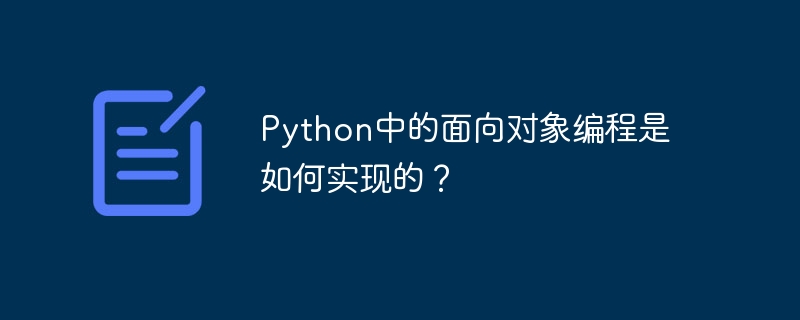

How is object-oriented programming implemented in Python?
Object-Oriented Programming (OOP for short) is a programming paradigm that is also widely used in Python. Through object-oriented programming, we can organize data and functions in the program into objects and implement complex logic based on the interactions between objects.
In Python, the implementation of object-oriented programming relies on the concepts of classes and objects. A class is a template that encapsulates data and methods, and an object is an instantiation of a class. Below we use a specific code example to illustrate how object-oriented programming in Python is implemented.
First, we define a class named Person to represent a person. In this class, we define two attributes - name and age, which represent the person's name and age respectively. We also defined two methods - speak and walk, which represent human talking and walking behaviors respectively.
class Person: def __init__(self, name, age): self.name = name self.age = age def speak(self): print("My name is", self.name) def walk(self): print(self.name, "is walking")
In the above code,def __init__(self, name, age):represents a special method used to initialize the properties of the object. In this method, we set the name and age properties for the object throughself.name = nameandself.age = age.
Next, we can use the defined class to create an object and call the object's method. For example, we can create a Person object named Alice and call its speak and walk methods:
alice = Person("Alice", 25) alice.speak() alice.walk()
After executing this code, the output result is as follows:
My name is Alice Alice is walking
As you can see, through With the definition of a class, we can easily create and manipulate objects, each with its own properties and methods. This method can better organize and manage code and improve development efficiency.
In addition, Python also supports inheritance between classes, through which code reuse and expansion can be achieved. For example, suppose we have a new class Student, representing a student, then we can let the Student class inherit the Person class and add new properties and methods to the Student class:
class Student(Person): def __init__(self, name, age, grade): super().__init__(name, age) self.grade = grade def study(self): print(self.name, "is studying")
In the above code,super().__init__(name, age)means calling the initialization method of the parent class (Person), which is used to set the name and age attributes. We also added a new method study to represent students' learning behavior.
Through inheritance, we can create a Student object and call its methods inherited from the parent class, as well as additional methods added by ourselves:
bob = Student("Bob", 18, 12) bob.speak() bob.walk() bob.study()
After executing this code, the output result is as follows:
My name is Bob Bob is walking Bob is studying
As you can see, the inheritance mechanism makes code reuse and extension simpler and more flexible.
To sum up, object-oriented programming in Python is implemented through the concepts of classes and objects. By defining classes and creating objects, we can organize and manage code and implement complex logic. At the same time, through the inheritance mechanism, we can achieve code reuse and expansion. Object-oriented programming is an important feature in Python. Being proficient in the principles and techniques of object-oriented programming can help us write programs with a clearer structure and higher maintainability.
The above is the detailed content of How is object-oriented programming implemented in Python?. For more information, please follow other related articles on the PHP Chinese website!




